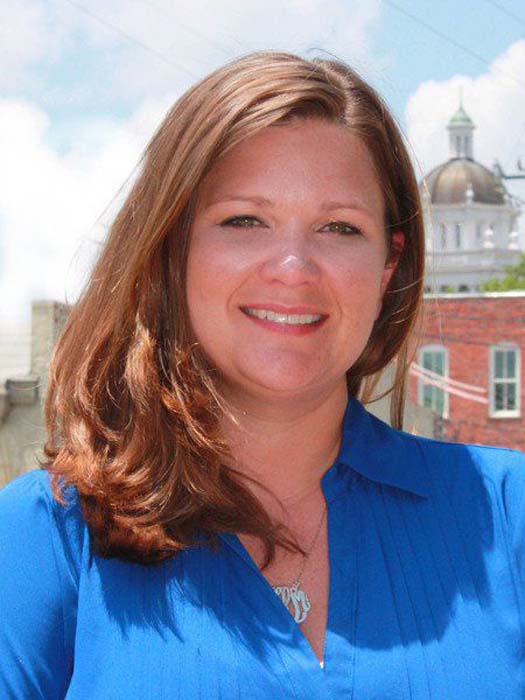— A SunLight Project Special Report — Downtown: A Sense of Place
Published 2:00 am Sunday, January 22, 2017

- Ellen Hill
VALDOSTA — A strong sense of place.
According to Main Street America — an organization focused on downtown revitalization across the nation — a vibrant downtown district goes a long way toward giving a community its character, vibrancy and identity — a sense of place.
Downtown districts in Dalton, Thomasville, Moultrie, Valdosta, Tifton and Milledgeville, Ga., along with Live Oak, Jasper and Mayo, Fla., have had varying degrees of success when it comes to preserving, restoring or creating that sense of place.
By all accounts, one of the great success stories in the entire region is the City of Thomasville.
PorterBriggs.com named Thomasville “Nicest Place in the South” this month.
PorterBriggs said, “People have been flocking to Thomasville, Georgia, for over 150 years, and you’ll only have to be here for a moment to see why. Since the years following the Civil War, when Thomasville was dubbed the Winter Resort of the South, the city has been refining its finely crafted hospitality, which is doled out in great helpings to visitors and residents alike. With the meticulously restored Victorian facades and brick-paved paths of its downtown, ample museums to explore and plantations to marvel at, hunting, shopping and dining galore, Thomasville has perfected the art of blending modern amenities with Old Southern charm, easily making it one of the Nicest Places in the South.”
Those are the kinds of accolades any city or downtown district would covet.
So, what does it take to be the “nicest place in the South?”
Downtowns across Georgia and North Florida are a blend of old and new — historic buildings next to more modern storefronts, traditional restaurants neighboring trendy night spots, vintage movie theaters flanking avant-garde boutiques and lively cafes. Lawyers, architects and entrepreneurs work inside buildings that were constructed in the early to mid 1900s or earlier. Children and families stroll through public green spaces that sit near aged courthouses and other imposing government buildings.
Main Street suggests the strong sense of place is a characteristic “rarely associated with regional malls, big-box retailers or suburban commercial corridors.”
Specifically, Main Street has said, “A strong sense of place is vital to the health and prosperity of a downtown, especially in smaller cities.”
The History
Most every town began with its downtown.
A city’s history is inextricably tied to its downtown district and hallmark buildings.
Downtowns have long been seen as a city’s cultural and historic center, areas that showcase a town’s unique character and charm — the heart and soul of a community.
But downtowns took a tumble in the 1970s and ’80s with the rise of malls and strip centers, said Ellen Hill, the director of Valdosta Main Street. Commerce, which had before been mostly concentrated in downtown areas, spread to other sectors of the city.
Businesses left downtown, and many historic squares and Main Streets fell prey to decay and disrepair.
It happened in Valdosta, but it was a trend seen nationwide, Hill said.
Efforts have been made in past decades to restore downtowns to their former glory.
Such efforts are still in full swing in the towns covered by the SunLight Project.
The Future
Revitalization is the buzzword for downtowns, the bringing of new life and vitality to areas that were and still are staples of the community.
The survival and success of the modern downtown depends on that crucial balance between the old and new. Downtown officials are tasked with preserving a city’s historic infrastructure and identity while still bringing in modern businesses and entertainment, fun events and innovative ideas that collectively draw visitors and make the area profitable.
Downtown districts in Georgia and North Florida are just as diverse as the people who live, work and play there, and cities have had varied success when it comes to downtown revitalization.
People all across Georgia and Florida know about Thomasville’s lively downtown, but can the model followed by city and community leaders there be imitated? Should it be?
What have city and community leaders across Georgia and North Florida done right to preserve or grow their downtown districts?
What have they done wrong?
Or is success solely dependent on the private sector and driven by free-enterprise?
Dalton just received a $1 million pledge for a new performance venue downtown, and Milledgeville has been nationally recognized for its downtown, receiving in 2013 the elite Great American Main Street Award.
The small downtown area in Live Oak isn’t at the “vibrant stage” just yet, although it’s getting there, said Jimmy Norris, executive director of the Suwannee County Chamber of Commerce.
Live Oak’s downtown already includes three public green spaces, and Moultrie is implementing plans to increase downtown green space by 40 percent. In contrast, downtown Valdosta’s only green space is essentially the courthouse lawn, and downtown Tifton’s green space is non-existent.
However, Valdosta is designated as a Georgia Exceptional Main Street for meeting certain downtown standards. And Tifton is making a push to transform downtown buildings into apartments and condos in response to interest in downtown living.
Towns such as Jasper and Mayo usually have an even harder time getting businesses to set up shop downtown because of the the small-town population.
While downtowns are diverse and at different stages of revitalization, they face many of the same challenges.
Some downtowns struggle to get funding to renovate old buildings or to implement new marketing strategies. Other downtowns have trouble attracting visitors, especially young people. Many downtowns have to compete for business with malls and other centers of commerce.
Downtown officials are also constantly fighting to recruit new businesses, a fight that isn’t easily won, as evidenced by the vacant, rundown buildings that dot many downtowns.
Regardless of the obstacles, authorities from multiple towns said a lot of progress has been made to bring local downtowns back to life, a task that many describe as a marathon, not a sprint.
The Success Stories
When it comes to judging downtown success, a good place to start is the National Main Street Center, an organization that oversees thousands of downtown communities across America.
Each year, the NMSC gives the Great American Main Street Award to a handful of cities. Since the award started in 1995, approximately 90 communities nationwide and only four cities in Georgia have received the title. Two Georgia communities are Thomasville and Milledgeville (the other two Georgia cities are Rome and Dahlonega).
The NMSC, or Main Street America, chooses winners based on several factors, including the town’s overall success in creating an exciting place to live, work, play and visit; the commitment to historic preservation; and the level of active involvement from the public and private sector.
Thomasville was the first Georgia city to receive the GAMSA in 1998. Now a city of about 19,000, Thomasville’s downtown includes 21 restaurants, 80 retail stores, an amphitheater facility, professional offices, apartments and condos.
Since 1981, more than $87 million has been reinvested in downtown Thomasville in public and private improvements. In addition to facade restorations on downtown storefronts by individuals with grants and other funding, city government has boosted downtown by providing an amphitheater facility, removal of asphalt exposing downtown’s original brick streets, improved parking at storefronts, improved sidewalks and enhanced lighting and landscaping.
“We created a sense of place,” said Lynn Williams, Thomasville assistant city manager.
Downtown Thomasville hosts a full calendar of events, big and small, throughout the year, and on any given day, there is usually at least one downtown activity to attend. Two of the biggest events are Victorian Christmas and the Annual Rose Show, Parade and Festival. Thomasville even pulls people in from much bigger cities; 50 percent of the city’s downtown sales comes from Tallahassee, Fla., shoppers, Main Street America said.
Milledgeville, a town of about 19,000, received its GAMSA in 2014. Sandwiched between the main campuses of both Georgia College and Georgia Military College on either side, the city’s downtown is in a prime location for business.
It boasts 25 restaurants/dessert shops, 23 retail stores, and more than 30 other businesses. The Milledgeville Main Street sphere of influence covers a six-block by nine-block radius and includes Georgia College’s beautiful Black Box Theatre in the center of the main block.
The downtown community is also home to three local farmers markets, monthly First Friday events (music and family-friendly programs) and the annual Deep Roots Festival, an award-winning event, which for the past 15 years has attracted thousands to see and hear bands and artisans from across the country.
Milledgeville, like Thomasville, offers multiple programs and grants to help downtown businesses renovate storefronts and market their products. The downtown has also received millions of dollars of investment in recent years, allowing the area to continue to grow and improve.
Carlee Schulte, Milledgeville Main Street director, said winning the GAMSA energized the community.
“We really wanted to make people feel proud of where they’re from and where they’re at, and gain a sense of community pride that I think was needed,” Schulte said.
Schulte said Main Street America’s four-point strategy was a key factor in helping downtown Milledgeville succeed.
“The four points (are) design, organization, economic development and promotion,” Schulte said. “Promotions are different events and ‘Shop Local’ campaigns. Economic development are projects that happen downtown in which we help to fund money through opportunities that we have through the State Department of Community Affairs.
“Organization is our board and committees and volunteers, and design is helping with the streetscapes, banners, and making sure downtown is pedestrian-friendly and looking good as a whole.”
The Competition
All of the SunLight Project cities, except for Live Oak, Jasper and Mayo, are accredited through Main Street America, meaning they meet certain downtown standards.
Valdosta goes one step further by being one of only eight Georgia Exceptional Main Streets, a designation given to cities by Georgia Main Street for being “proven leaders in their field of downtown development” (Thomasville and Milledgeville also hold the title).
Valdosta has a population of about 56,000 people. In the downtown core, there are about 130 businesses, which include 11 cafés/restaurants and a diverse mix of shopping, arts and entertainment services and venues, churches and government and professional services. Downtown Valdosta also has 115 loft apartments, and hosts several events throughout the year, including First Fridays and Farm Days.
Since 1998, Valdosta’s downtown has seen $50 million in private investment — $7.5 million in 2016 alone.
“Valdosta has come a long way, and we are always working to make our downtown a more vibrant and enjoyable destination,” Main Street Director Hill said.
She said one of the challenges downtown Valdosta faces is competition with a thriving mall, something other downtowns, such as Thomasville, don’t have to deal with. Commerce is split between the mall and downtown areas, making it harder to draw people downtown, Hill said.
She said her goal is not to make downtown the only center of commerce, as it was decades ago.
“I don’t really want to go back to that point because the world is so different,” Hill said. “Would I like to see it booming and this be the only place to shop? Sure, but I’m realistic enough to know that there is a place for Walmart in the world.
“There is a place for the mall. Those things are great and they do wonderful things for the local economy as well. But I do feel like our concentration of downtown businesses are more important because they are owned by local people and this money does stay within the community.”
The Impact of Small Businesses
The Small Business Administrations says 68 cents of every dollar spent at a local business stays within the community. For chain stores it’s 20 cents, and for big box stores, it’s only six.
Lequrica Gaskins, economic development director for Tifton’s Downtown Development Authority, credits the small business owners with successfully pushing the city’s downtown forward.
“I think our small business owners are the heartbeat of our community and our downtown,” Gaskins said. “I’d also credit the public/private partnerships. It takes a team to build a village, everybody being a team player. Through the downtown development authority, the city has really made sure the downtown has thrived. They take that mission seriously.”
The downtown area of Tifton, a city of about 17,000, stretches across three-and-a-half blocks heading north to south and two blocks heading east to west. Approximately 120 businesses and organizations are located in the downtown area.
The three most prevalent retail establishments located downtown are clothing (14), salon/barbershops (11) and home decor/furniture and thrift shops are tied at nine each.
There are seven sit-down restaurants, two of which have outdoor dining spaces, and four other food establishments specializing in desserts.
There are also three bars/clubs, all of which offer live music and entertainment during the weekends. There are three museums or historic buildings and one memorial park, along with the historic Tift Theater which puts on plays and hosts concerts approximately once a month.
The largest celebration or event that happens downtown is the Hometown Holidays celebration during Christmas. Most of the large events take place in the local park, which is about a mile away.
The Empty Buildings
Although buoyed by small-business optimism, Downtown Tifton still has 20 empty buildings, a problem for all downtowns.
Moultrie, a city of about 14,000, has only four downtown vacancies, a comparatively low rate.
The 17 blocks that comprise downtown Moultrie are home to about 50 retail shops, eight sit-down restaurants, and two live-music venues.
Amy Johnson, Moultrie’s Main Street director, credited the city’s participation in the Main Street program for the vibrancy of Moultrie’s downtown. Remaining an accredited Main Street program is important, she said, because many grants are available only to communities with such a program. The grant money often is the driving force for development in downtowns everywhere.
Despite the struggle to get and keep businesses, downtown officials still believe downtown deserves a special place in the community.
“Downtown should be the heart of every community,” Johnson said. “That’s where the heartbeat is.”
Live Oak, a city of about 7,000, has 17 vacancies downtown, a high rate for such a small town. Its downtown area holds nine restaurants, 12 retail shops, 52 businesses and two live-music venues. Like many other downtowns, Live Oak hosts First Fridays and various holiday events and festivals throughout the year.
“I think, the point is to increase the vibe downtown. We’re not at the vibrant stage yet, but I do think we’re getting there,” Suwannee County’s Jimmy Norris said. “With some of the events, the festivals, the things we’re bringing downtown, I know that many of the individuals that have attended have expressed to us just how excited they were to be there.”
Keith Mixon, Live Oak’s City Council president, said to pull more businesses and visitors downtown, the city has to “incentivize folks.”
“You’ve got to have quality of life. You’ve got to incentivize folks, give them a reason to have to go downtown to enjoy with their family and friends,” Mixon said. “Incentivizing downtown with more than a splash here and a splash there. We’ve got to give people a reason to go downtown. Today there’s nothing there.”
Close to Live Oak, Jasper has a small downtown that includes one restaurant, three retail stores and one museum. The town of about 4,000 people holds a few events downtown throughout the year. Jasper’s small downtown core currently has 12 vacancies.
“We have plenty of opportunity for growth and revitalization (in downtown Jasper),” said Susan Ramsey, Hamilton County Development Authority Executive Director. “The stores that we do have and businesses that (are here) have a long standing reputation.
“My goal for 2017 is to identify the location, areas, businesses or buildings that are available for opportunity of growth and strategize on how we can get a business in there.”
Mayo, a town of about 1,200, only has two restaurants and three retail stores downtown. There are nine vacancies, but one history museum is in the works.
“As president of the chamber, I am trying to fill these buildings that are so empty,” Lafayette County’s Vi Johnson said about downtown Mayo. “I would like to see quaint little shops in each one of these, but it is so hard to find one that wants to come here.”
Many downtowns offer financial incentives and grants for prospective businesses, and Main Street programs work to market downtown districts to their respective communities.
Valdosta’s vacancy rate stays at about 15 percent, Hill said. Currently, there are 23 empty buildings in downtown Valdosta.
Even Thomasville has a couple dozen vacancies. Milledgeville sticks close to Moultrie with just three empty buildings and five vacant storefronts. Dalton has 16.
The Marathon
“It’s a marathon, not a sprint,” downtown officials have repeatedly said.
They agree that downtown development and improvement takes time and often depends on factors that Main Street programs can’t always control, such as the amount of investments being poured into a downtown.
Dalton, a city of about 34,000, got a big Christmas present in 2016. In December, Jeanne Burr, a private donor, pledged $1 million to build a new performance venue at the former site of an industrial building and to fund programming in the venue.
In return, the Dalton City Council agreed to make the site of the building, which they had demolished after it had been donated to them earlier, a permanent park.
Downtown Dalton Development Authority Director Garrett Teems said the donation is a huge vote of confidence in downtown and it will also be a big boost to the city’s central business district.
“This new park, and that venue, is almost exactly in the center of downtown,” Teems said. “We have so many businesses and restaurants so close to it, within walking distance.”
Downtown Dalton has 15 restaurants, 37 retail shops, six live-music venues and several theaters and museums. The area hosts about 40 festivals, concerts and other events each year, which Teems said draw more than 22,000 people a year to the district.
One of the main needs for Dalton’s downtown is to expand its streetscape work.
“That’s putting the utilities underground, redoing the drain systems, redoing all the streetlights. The south end of town has been a big focus for new business. But putting new businesses on top of aging infrastructure is never a good mix,” Teems said.
Hill said downtown development will never stop.
“It’s a marathon, not a sprint. Downtown development everywhere is always going to be an incremental revitalization of a district,” Hill said.
“(It’s) ever-changing, you’re not always going to get to the ultimate goal because those goals always change. You always want it to be better. We’re not ever finished.”
Missy Smith, Valdosta Main Street coordinator, said the best thing about downtowns is that each one is so different and unique.
“Malls you can walk into and you know what to expect. They’re all going to be the same,” Smith said. “But when you go and visit a town, where do you go? You don’t go to the mall. You go to downtown because that’s where you see the character of each individual place.”
The SunLight Project team of journalists who contributed to this report includes Charles Oliver, Billy Hobbs, Alan Mauldin, Eve Guevara, Patti Dozier and Thomas Lynn, along with the writer, team leader John Stephen. Jason Smith and Will Woolever also contributed to the report.
To contact the team, email sunlightproject@gaflnews.com.





